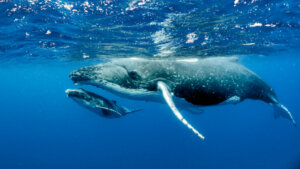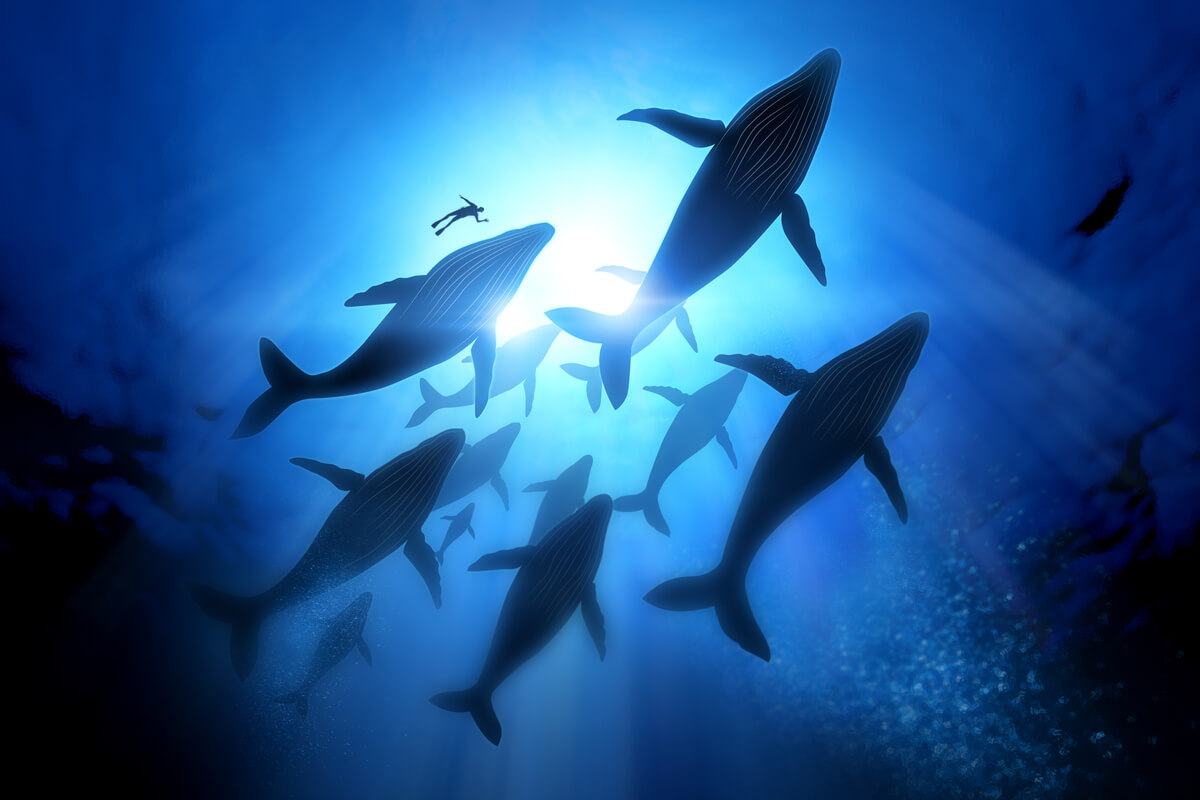How Do Whales Reproduce and How Are They Born?

We know about whales and other marine cetaceans through different sightings, but this is only a small part of their life. What happens the rest of the time under the depths of the sea? How do whales reproduce? And how are they born?
Whales are marine mammals. As such, they reproduce in the water. The female whale goes through a long gestation and gives birth to a calf, which she’ll nurse for a full year. Want to know more about reproduction in these animals? Read on.
How do whales reproduce?
Although there are slight variations between different species of whales, whales reproduce when males and females reach sexual maturity – between 5 and 7 years of age. Whales are internally fertilized and mating can occur at a certain time of the year, when females are receptive, or even all year round.
They’re also polygamous mammals whose reproduction takes place among several individuals. This increases the success of reproduction and the genetic variability of the species, at least in the long term.
For example, in the case of southern right whales – contrary to what happens in other species – there’s no competition when looking for a mate and the female can copulate with all the males of a group. The battle occurs at the sperm level: the mother becomes pregnant with the male with the highest seminal quality.

Does courtship exist in whale species?
We also find differences between whale species during courtship. Some of them may seem violent, as there are fights between males where they hit their opponent with their fins or their heads. Others are more relaxed and consist of singing, calling, and rubbing females.
Male humpback whales (Megaptera novaeangliae) are a good example of courtship through continuous and changing songs during the breeding season. The sound waves can travel quite far and serve to indicate their location to females. This ability isn’t only used for mating, but also as an excellent method of communication.
Whales reproduce in a rather unusual way, as, on many occasions, three whales participate. More than once it has been possible to record this behavior in individual gray whales.
There are several theories that try to explain this interaction. Some support that the third male would have the function of collaboration to ensure mating, doesn’t get involved in the act, while other theories support copulation with multiple males without any aggression between them.
How do whales mate?
The process is relatively simple, as the male turns and gets under the female to touch her with his belly. At that moment his reproductive apparatus comes out of its cover and penetrates the partner to inseminate her. This is done while both are swimming slowly or when they’re almost static in one place.
Although it sounds simple, whale copulation can last several hours. This usually happens when some females refuse to mate and swim on the surface with their bellies up to avoid copulation. The males struggle for a long time to turn them over, which delays this process.
Gestation and lactation in whales
The gestation period ranges from 10 to 16 months, depending on the species of whale. It’s a long gestation and takes place in the water. The whales choose the warmest waters to give birth during these migrations. Usually, only one calf is born at a time.
The mother helps the calf to surface to breathe after birth and the calf will stay with its mother for its first year of life. The size of a calf depends on the species and the size of the mother, but, as a general rule, calves are usually about 6% of the bodyweight of the adult female.
During the first year, calves can’t stay underwater as long as adults, so they need continuous help from their mothers. Nursing occurs below the surface, calves can’t breathe and feed at the same time, so given the effort they make to eat, nursing periods tend to be short.
Breast milk contains enough fat – around 45-60% – to allow the calf to grow even if nursing is short.
Whale calves call their mothers
The relationship of the calves with their mothers is a very close one. In an aquatic environment and with possible predators, it’s important to maintain this bond.
The whale calves live at their mothers’ sides during the first year of life, swimming close to her all the time and communicating through discreet calls and rubbing. These faint calls allow the mother to keep an eye on her calf, while remaining unnoticed by predators such as killer whales or other males who want to mate with the female.
Unfortunately, it’s believed that noise pollution at sea may be interfering with communication between whales.

In summary, whales have a long life cycle and reproduction occurs when females reach sexual maturity at around 7 years of age and mate several times, with one or more males. After a long gestation, they give birth to a single calf, which will stay with them for the first year of its life.
We know about whales and other marine cetaceans through different sightings, but this is only a small part of their life. What happens the rest of the time under the depths of the sea? How do whales reproduce? And how are they born?
Whales are marine mammals. As such, they reproduce in the water. The female whale goes through a long gestation and gives birth to a calf, which she’ll nurse for a full year. Want to know more about reproduction in these animals? Read on.
How do whales reproduce?
Although there are slight variations between different species of whales, whales reproduce when males and females reach sexual maturity – between 5 and 7 years of age. Whales are internally fertilized and mating can occur at a certain time of the year, when females are receptive, or even all year round.
They’re also polygamous mammals whose reproduction takes place among several individuals. This increases the success of reproduction and the genetic variability of the species, at least in the long term.
For example, in the case of southern right whales – contrary to what happens in other species – there’s no competition when looking for a mate and the female can copulate with all the males of a group. The battle occurs at the sperm level: the mother becomes pregnant with the male with the highest seminal quality.

Does courtship exist in whale species?
We also find differences between whale species during courtship. Some of them may seem violent, as there are fights between males where they hit their opponent with their fins or their heads. Others are more relaxed and consist of singing, calling, and rubbing females.
Male humpback whales (Megaptera novaeangliae) are a good example of courtship through continuous and changing songs during the breeding season. The sound waves can travel quite far and serve to indicate their location to females. This ability isn’t only used for mating, but also as an excellent method of communication.
Whales reproduce in a rather unusual way, as, on many occasions, three whales participate. More than once it has been possible to record this behavior in individual gray whales.
There are several theories that try to explain this interaction. Some support that the third male would have the function of collaboration to ensure mating, doesn’t get involved in the act, while other theories support copulation with multiple males without any aggression between them.
How do whales mate?
The process is relatively simple, as the male turns and gets under the female to touch her with his belly. At that moment his reproductive apparatus comes out of its cover and penetrates the partner to inseminate her. This is done while both are swimming slowly or when they’re almost static in one place.
Although it sounds simple, whale copulation can last several hours. This usually happens when some females refuse to mate and swim on the surface with their bellies up to avoid copulation. The males struggle for a long time to turn them over, which delays this process.
Gestation and lactation in whales
The gestation period ranges from 10 to 16 months, depending on the species of whale. It’s a long gestation and takes place in the water. The whales choose the warmest waters to give birth during these migrations. Usually, only one calf is born at a time.
The mother helps the calf to surface to breathe after birth and the calf will stay with its mother for its first year of life. The size of a calf depends on the species and the size of the mother, but, as a general rule, calves are usually about 6% of the bodyweight of the adult female.
During the first year, calves can’t stay underwater as long as adults, so they need continuous help from their mothers. Nursing occurs below the surface, calves can’t breathe and feed at the same time, so given the effort they make to eat, nursing periods tend to be short.
Breast milk contains enough fat – around 45-60% – to allow the calf to grow even if nursing is short.
Whale calves call their mothers
The relationship of the calves with their mothers is a very close one. In an aquatic environment and with possible predators, it’s important to maintain this bond.
The whale calves live at their mothers’ sides during the first year of life, swimming close to her all the time and communicating through discreet calls and rubbing. These faint calls allow the mother to keep an eye on her calf, while remaining unnoticed by predators such as killer whales or other males who want to mate with the female.
Unfortunately, it’s believed that noise pollution at sea may be interfering with communication between whales.

In summary, whales have a long life cycle and reproduction occurs when females reach sexual maturity at around 7 years of age and mate several times, with one or more males. After a long gestation, they give birth to a single calf, which will stay with them for the first year of its life.
All cited sources were thoroughly reviewed by our team to ensure their quality, reliability, currency, and validity. The bibliography of this article was considered reliable and of academic or scientific accuracy.
- Zoidis, A., & Lomac-MacNair, K. (2017). A note on suckling behavior and laterality in nursing humpback whale calves from underwater observations. Animals, 7(7), 51.
- Videsen, S. K., Bejder, L., Johnson, M., & Madsen, P. T. (2017). High suckling rates and acoustic crypsis of humpback whale neonates maximise potential for mother–calf energy transfer. Functional Ecology, 31(8), 1561-1573.
- Oftedal, O. T. (1997). Lactation in whales and dolphins: evidence of divergence between baleen-and toothed-species. Journal of mammary gland biology and neoplasia, 2(3), 205-230.
This text is provided for informational purposes only and does not replace consultation with a professional. If in doubt, consult your specialist.








